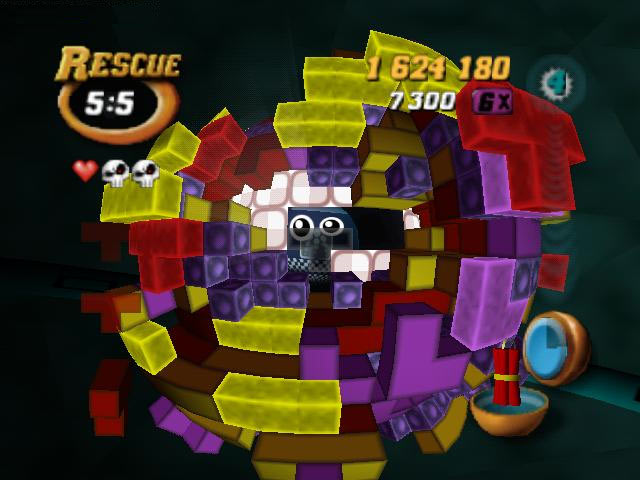
Tetris, Dr. Mario, Puzzle League… There are many classic puzzlers that we’ve seen on Nintendo machines time and again. Yet there are many other unsung heroes of the puzzle genre that need their due this week, and we’re going to remedy that, just a little, with a miniseries of stories calling out some favorite puzzle games that didn’t reach the same echelons as Pokémon Tetris Jewel Attack League: Revenge of Dr. Bean’s Columns.
Tetrisphere
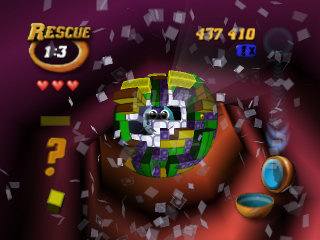 Developed by: H20 Entertainment
Developed by: H20 Entertainment
Sole Nintendo Release: August 1997 (North America) on Nintendo 64
What It Was About: The first puzzle game released on Nintendo 64, after being snatched from the claws of obscurity as a Jaguar title named “Phear,” this was one of the first console puzzlers to put 3D to a mesmerizing and challenging use. It featured cutesy robots, but the cutting edge, digital sample-tinged techno soundtrack from Neil Voss and the serious gameplay mechanics made for a fantastic puzzler.
Imagine a 32 x 32 grid of Tetris blocks, except wrapped around a sphere, and with multiple layers of blocks on top of one another. To destroy this Death Star of Tetrominoes, you must drop your own Tetris pieces on top of the planetoid. If your piece falls adjacent to a same-shaped piece, or falls on directly top of one, you may trigger a “reaction.” A reaction occurs when a set of three same-shaped pieces are created or touched via your well-placed block– meet this goal and all those blocks explode, as well as all adjacent same-shaped pieces. Executing massive reactions will reward power-up items such as a bomb that will clear a chunk of blocks with disregard to matching. In the standard single player “rescue” mode, your objective is to clear away enough of the planet’s layers until a robot trapped within the planet’s core can fit through a hole made by you and escape. Rather random for an objective, but still so much fun.
Where’d It Go? In spite of a mediocre marketing effort (no surprises there), the game received good critical marks and sold 430,000 copies worldwide by March 31, 1998, according to Business Wire. There have been Wii games that were called “successful” after selling less than that. Developer H20 doesn’t exist anymore, so the game’s absence in remakes and sequels may be attributable to that, but I can only imagine how great a modern day version would be with more powerful hardware– and potentially even in 3D on 3DS, with touch controls for precise block dropping and planet-spinning. Unfortunately, while there have been plenty of great consoles this game could have resurfaced on, it hasn’t, so this may be one of the only time we’ll see a Tetris spin-off that was actually quite terrific.
Wetrix
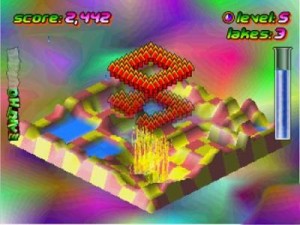 Developed by: Zed Two
Developed by: Zed Two
Sole Nintendo Release: June 12, 1998 (North America) on Nintendo 64
Last Seen: January 9, 2001 (North America) Aqua Aqua sequel released on PS2
What It Was About: Who wouldn’t love a game that labels its blocks “uppers” and “downers” without irony? Like Tetrisphere, this game was a favorite of mine because it used 3D graphics to make a very tricky puzzle game.
A small landscape is floating against a potentially psychedelic background. Tiles of various properties– land, bombs and water– fall one at a time on the landscape. The gamer must strategically place the land pieces– uppers and downers– to create mountains and valleys that will become reservoirs to hold the falling water pieces. By catching water within these reservoirs, instead of allowing it to realistically run off the edge of your landscape, gamers create point-gathering opportunities. With large enough reservoirs, ducks will start swimming in them and rainbows will arc across them, both of which multiply your points while on-screen.
Then the godlike aspect is introduced– fireballs. By nuking a lake or pond with a fireball, the water is instantly evaporated, and that’s the primary source of points. The gamer must take care in not putting too much land (or uppers) on the landscape, though– with too much weight, the “earthquake” meter will max out, destroying and randomly redistributing your carefully implemented landscape and usually ending the game, unless you’re very lucky. So, use those downers to “trim” the excessive mountains, and use uppers to fill in any holes caused by bombs.
Wetrix is a strange combination of Zen gardening, terraforming, water conservation and environmental disaster. What’s not to love?
Where’d It Go? Not a lot of my friends know about this one, so I wouldn’t be surprised to hear it didn’t sell well. While the premise is very novel and captivating, the game’s also not pick-up-and-play easy. This title requires practice, and a lot of patience, especially since the earthquake feature is designed to punish and end your game for playing fast and loose. I tried to get friends to play multiplayer with me, but we quickly had to turn it off. That’s a shame– but also a sign why we’ve not seen the game since a simplified PS2 sequel.
Klax
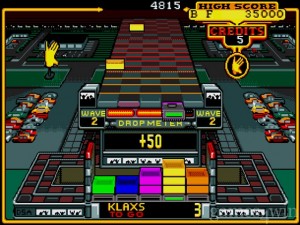 Developed by: Atari Games
Developed by: Atari Games
First Nintendo Release: 1990 (NA) on Nintendo Entertainment System
Last Seen: 2005 (NA) Game Boy Advance 2-Pack Re-release with Marble Madness
What It Was About: “IT IS THE NINETIES AND THERE IS TIME FOR KLAX.” Ain’t that the truth? That little phrase was part of what this “tic-tac-tile” game would tell you if it sat on the title screen long enough.
Klax is an American-made puzzler created by Atari brainchildren as a substitute to Tetris when Atari was having a legal battle over the Russian title’s licensing. Klax, kind of like Sonic, was released with a too-cool-for-school vibe, defining what “hip” video games should be in an almost obnoxious way. Fortunately, the game had (at the time) cool digitized sound effects and fun gameplay.
Solid-colored tiles would flip and flop down a conveyor belt towards a little, hovering “catcher” the gamer could slide back and forth. The gamer could catch and hold up to five tiles at once, and even flip them back up a ways on to the conveyor belt to deal with a little later, if desired. But the main objective was to drop the caught tiles into a grid below the catcher, creating horizontal, vertical or even diagonal lines of three to five like-colored tiles. In a novel twist, creating an “x” pattern with the tiles on the first level would allow the gamer to warp forward to level 45 (the game had 100 levels total), and every five levels provided an additional option to warp forward an extra five or ten levels instead of proceeding one level at a time.
Funky, artistic backgrounds and the strange soundtrack caused by the flopping tiles made the game memorable, but the challenge of juggling those tiles to create single-color lines was the real magic. It was about as close as a game could get to matching the simple rules and strategic depth of Tetris (at the time, anyway) without actually surpassing the gold standard.
Where’d It Go? The game was ported to pretty much any electronic machine that could play video games in the early ’90s, and while no effort has been made to reinvent it, Klax has shown up in a number of arcade compilations since, most notably Midway Arcade Treasures, which was released on PS2 and GameCube in 2003. The 2005 Game Boy Advance two-pack was the last time this “rad” gem has reappeared, so it may go softly into the night, with not even an XBLA HD remake, given an absence of five years and counting.
ChuChu Rocket!
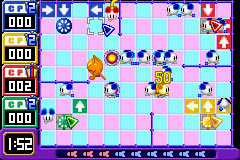 Developed by: Sonic Team
Developed by: Sonic Team
First Release: February 29, 2000 (NA) on Sega Dreamcast
Last Seen: June 10, 2001 (NA) on Game Boy Advance
What It Was About: How I love that this game was released on GBA so that I might include it here. You didn’t get the excellent GBA version that supported single-cartridge multiplayer and had 2,500 user-created levels? Shame on you. Multiplayer Tetris may be fun with all the powerups in Tetris DS or just the “junk pieces” that rain down on opponents in other variations, but ChuChu Rocket! takes the crown for most frenetic, shoulder-checking puzzle action between friends.
ChuChu Rocket! has mice and cats trekking across a checkerboard floor. When they hit a wall they turn right, they follow around corners, and when they hit a dead end they turn a 180. Gamers are allowed to place up to four arrow tiles at once on the floor, in any direction, to change the mice’s paths, and potentially misdirect the cats. Mice that get into a gamer’s rocket score points, while mice that cross paths with a cat instantly die, and cats that get into your rocket eat a third of your on-board mice.
The frenzy occurs most in multiplayer, where your friends can drop an arrow that will redirect your carefully laid path into their rockets instead. Or a last-minute arrow tile change will drive a cat into your rocket. All the while, the mice stream from their starting point to unknown fates– death? rockets?– at an alarming speed that can actually be accelerated with a randomly drawn power-up. The game ends up being utter, joyful madness, all scored with a super-addictive theme song.
Where’d It Go?ChuChu Rocket! generally elicits a love it or hate it vibe. Newbies are prone to quickly throw up their hands because it seems too fast, and juggling arrow tiles (once you set a fifth tile, the first tile you placed disappears to ensure you have no more than four arrow tiles active at once) is rather awkward to grasp. Plus, as a showcase for Dreamcast’s online service, the game disappointed many critics, and that’s nothing to mention the Sonic fanboys who were irritated that Sonic Team was making something like this instead of a “true” Sonic sequel. Now if only everyone’s priorities were straight, we would have gotten Sonic 4 ten years ago, and ChuChu Rocket! would have gotten the sequels and reimaginings it deserved, too.




 ShareThis
ShareThis






